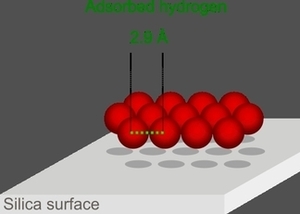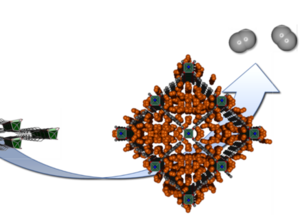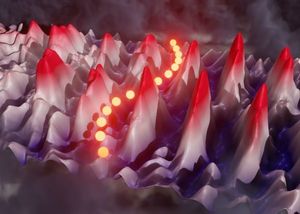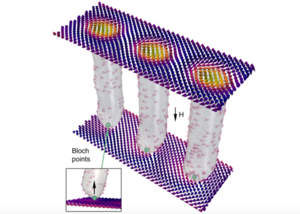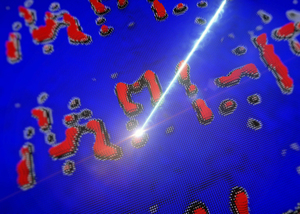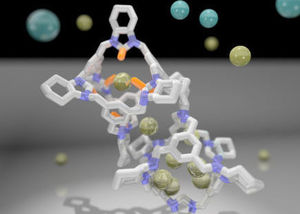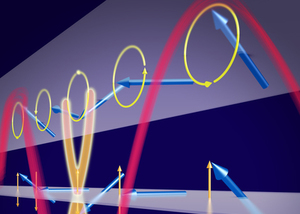Department News
Super-dense packing of hydrogen molecules on a surface
- 09 September 2022
In a paper in Nature Chemistry, scientists from the Max Planck Institute for Intelligent Systems, the Technische Universität Dresden, the Friedrich-Alexander-Universität Erlangen-Nürnberg, and Oak Ridge National Laboratory describe the formation of a superdense monolayer of hydrogen on highly ordered mesoporous silica near the boiling temperature. Theoretical studies and simulations confirm the experimental observations of the unusually high hydrogen density in the adsorbed layer and may also open new possibilities for enhancing the volumetric capacity of cryogenic hydrogen storage systems.
Flexible Quantum sieve filters the fuel of Starship Enterprise
- 13 April 2022
Deuterium, the heavy brother of hydrogen, is considered a promising material of the future – because of its wide range of applications: in science, for energy generation, or in the production of pharmaceuticals. However, the extraction of deuterium from its natural isotope mixture has so far been complex and expensive. With a porous material developed at the Technische Universität Dresden, this could soon be done more efficiently and cost-effectively. The new method has now been published in the scientific journal "Science Advances".
World's first video recording of a space-time crystal
- 09 February 2021
Periodic pattern consisting of magnons is formed at room temperature
A team of researchers has succeeded in creating a micrometer-sized space-time crystal consisting of magnons at room temperature. With the help of an ultra-precise X-ray microscope, they were able to capture the recurring periodic magnetization structure in a movie. The research project “Real space observation of magnon interaction with driven space-time crystals” was published in Physical Review Letters.
Demonstration of k-vector selective microscopy for nanoscale mapping of higher order spin wave modes
- 27 August 2020
Nanoscale Backcover
Higher order spin wave modes are deconvoluted by their k-vector and directly imaged with X-ray microscopy, achieving <20 nm spatial and <40 ps temporal resolution. These real space measurements allow a direct insight into the inner workings of complex spin wave systems and reveal their fine structure and localization profi le. While confirming analytical theory on the nanoscale, design paths towards multimode signal transmission in magnonic waveguides are shown.
Scientists prove the existence of Skyrmion tubes
- 30 April 2020
For the first time, an international team of researchers succeeded in demonstrating the previously unknown structure of magnetic skyrmion tubes in 3D. This knowledge makes it possible to better understand the formation and destruction of skyrmions and to use the magnetic structures in so-called spintronic storage devices.
Serendipity in the research field of magnetism
- 21 April 2020
Scientists discover new light-matter interaction with which they can write nanometer-sized magnetic structures
A German-Chinese research team has discovered a new effect that for the first time enables the creation of extremely small magnetic structures, known as skyrmions, directly with an X-ray beam. The scientists have thus made it possible to write arbitrary magnetic patterns with the highest precision.
Cage molecules act as molecular sieves for hydrogen isotope separation
- 03 November 2019
A new hybrid material developed by scientists at the University of Liverpool and the Max Planck Institute for Intelligent Systems may bring the dream of carbon-free nuclear fusion power a step closer.
Let’s not make big waves
- 29 March 2019
A team of researchers generates ultra-short spin waves in an astoundingly simple material
Due to its potential to make computers faster and smartphones more efficient, spintronics is considered a promising concept for the future of electronics. In a collaboration including the Max Planck Institute for Intelligent Systems and the Helmholtz-Zentrum Dresden-Rossendorf, a team of researchers has now successfully generated so-called spin waves much more easily and efficiently than was previously deemed possible. The researchers are presenting their results in the journal Physical Review Letters.
3D structure of skyrmions becomes visible for the first time
- 01 March 2019
An international team of scientists was able to make the indestructible magnetic structures visible for the first time with the aid of a high-resolution X-ray microscope.
Dr. Michael Hirscher Chair of the GRC Hydrogen-Metal Systems Conference
- 08 February 2019
The head of the "Hydrogen Storage" research group at the Max Planck Institute for Intelligent Systems in Stuttgart, together with Ned T. Stetson, will lead one of the most important conferences in the field of hydrogen-material interaction. The core topic of the conference will be new hydrogen storage materials, understanding from atomic level to applications.

